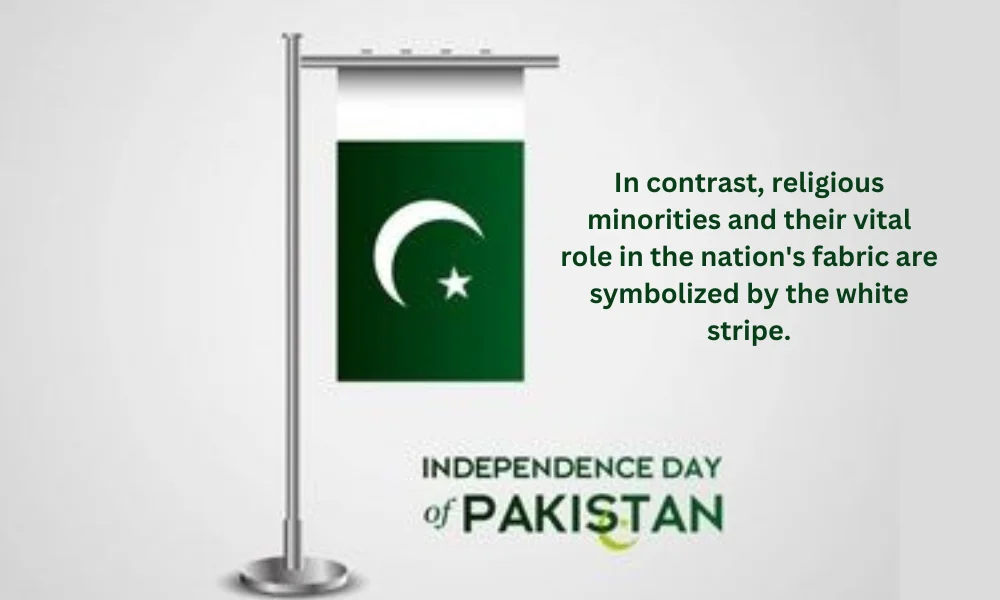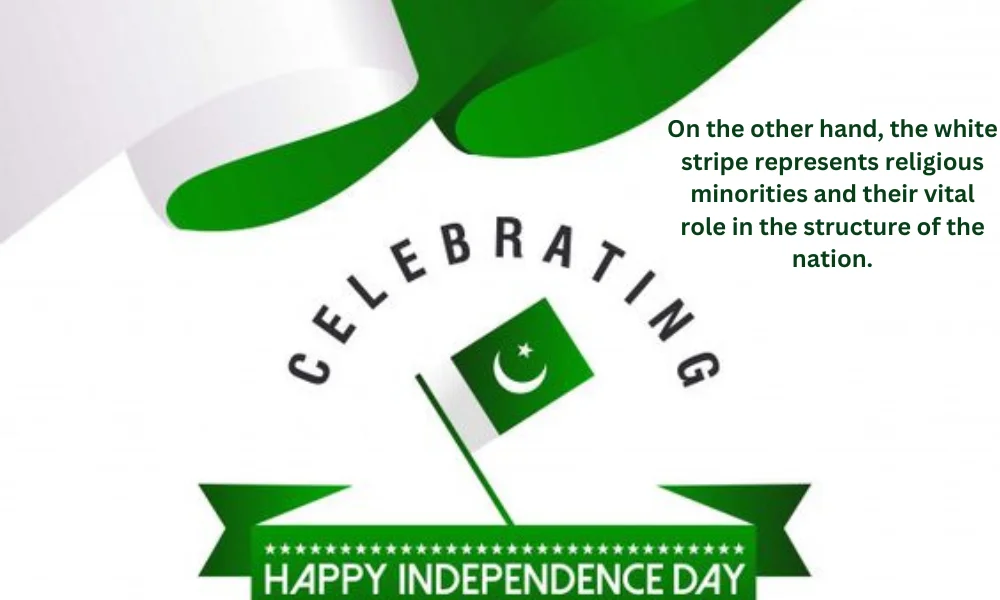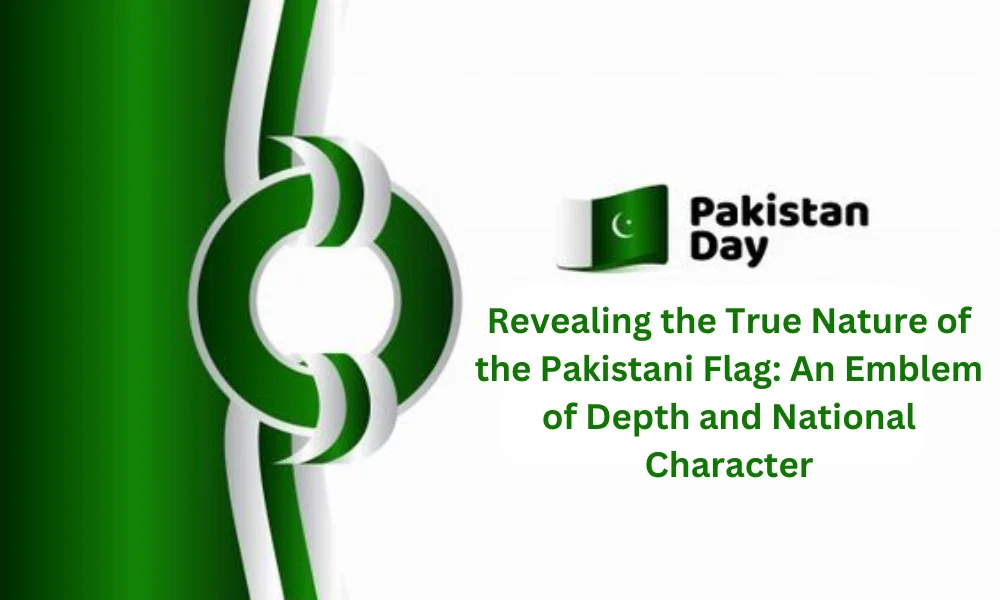Pakistan Flag
Unveiling the Essence of the Pakistan Flag: A Symbol of Rich Heritage and National Identity
Introduction (Pakistan Flag)
Standing tall and proud, the Pakistani flag symbolizes a country with a rich cultural heritage and a colorful past.

We explore the deep symbolism and minute elements included in the Pakistani flag in this in-depth investigation.
Historical Evolution
Inception and Design
When the Pakistani flag was first raised in recognition of the country’s independence on August 11, 1947, the trip took off.
The flag, designed by Amir Uddin Kidwai, has a compelling white vertical stripe on the left side that represents religious minorities and the nation’s dedication to religious harmony, while a brilliant green background symbolizes the Muslim majority.
Symbolism in Colours
(Pakistan Flag)
The flag’s vivid green colour is more than just a style decision; it also represents the country’s expansion, prosperity, and Muslim majority.
Conversely, the white stripe stands for religious minorities and their essential place in the fabric of the country.
The colours, a subdued yet impactful mix, reflect Pakistan’s identity as a nation united in diversity.
Design Elements (Pakistan Flag)
The Crescent and the Star
The graceful white crescent moon and five-pointed star to the right of the green field are two of the Pakistan flag’s most recognisable elements.
These emblems pay tribute to the nation’s Islamic heritage; the star stands for light, wisdom, and direction, while the crescent signifies advancement.
Proportions and Dimensions
A flag’s design must be precise; therefore, the Pakistani flag follows certain dimensions.
There is a pleasing visual equilibrium because the height of the white stripe and the width of the green field are equal.
This painstaking attention to detail is a reflection of the country’s dedication to quality and accuracy.
Cultural Significance (Pakistan Flag)
National Identity
The Pakistani flag represents more than just the country; it is a manifestation of the people’s collective identity.
It provides a sense of cohesion and pride by acting as a visual depiction of the values, beliefs, and common past that unite the diverse populace.
Ceremonial Importance (Pakistan Flag)
A major feature of national ceremonies and celebrations is the flag.
The unveiling of the flag is a ceremonial event that fosters a sense of patriotism and affiliation among the populace, whether it be during official government functions or Independence Day celebrations.
Etiquette and Respect
Handling and Display
Respecting the national flag is a serious obligation for all Pakistanis, not just a custom. The flag needs to be handled with the highest decency and regard.
To ensure that the honour it bears is maintained, it should never touch the ground, and its exhibition should follow the rules.

Half-Mast Protocol (Pakistan Flag)
As a symbol of respect, the Pakistan flag is flown at half mast during periods of national mourning or notable loss. This moving move highlights the national symbol’s deep emotional significance.
Conclusion (Pakistan Flag)
To sum up, the Pakistani flag is more than just a piece of cloth; it is a dynamic representation of the country’s ideals, past, and present.
Everything about it, from the finely detailed design components to the deep symbolism weaved into its colours, captures the spirit of Pakistan.
We recognise the responsibility that accompanies adopting such a potent sign of national identity as we honour this symbol of pride and unanimity.
Conclusion: Unveiling the Tapestry of Identity
The Pakistani flag is a colourful thread that unites the varied people of the country in the magnificent tapestry of countries, not merely a symbol.
The layers of design, history, and cultural importance contained within the folds of green and white have been revealed via this investigation.
Ever since its inception at the 1947 dawn of freedom, the flag has subtly observed the rise and fall of nations.
The finely crafted green background, designed by Amiruddin Kidwai, represents growth and wealth, while the white stripe represents religious peace and solidarity in the face of difference. It is evidence of the careful equilibrium that characterises Pakistan.
The star and the crescent moon, softly decorating the green canvas, honour the Islamic identity that runs through the veins of the country.
These symbols convey history, advancement, light, knowledge, and direction in addition to being purely aesthetic components.
The size and proportions are not just technicalities; rather, they represent the nation’s attention to detail and perfection and are a testament to quality.
The flag represents pride in the country and is associated with tradition and respect in all its manifestations, from its ceremonial use to its everyday flying. (Pakistan Flag)
The flag is more than just its physical manifestation; it goes beyond the rules and ceremonies.
It serves as a storehouse of common memories, a silent observer of victories and setbacks, and a focal point for happy and sad occasions.
It is a living phenomenon that gives Pakistani people’s shared values and ideals vitality.
Through our investigation, we have discovered something more than just a fragment of fabric—a living, breathing being that beats in time with the pulse of a country. (Pakistan Flag)
The Pakistani flag is a source of power, togetherness, and steadfast pride that leads its people through the tides of time.
As we honour this symbol of national identity, let us acknowledge the duty it places on every citizen to preserve the principles it stands for.
By embracing the flag, we also embrace the spirit of Pakistan as a whole—a spirit that flies high, led by the star and the crescent moon, towards a future lighted by the hues of prosperity and unification.

Pakistan Flag Meaning
(Pakistan Flag)
The Pakistani flag is a potent symbol that captures the spirit of the country’s identity and goals.
It has deep symbolic meaning. Let’s explore the meanings that are ingrained in its design:
- Green Background: Growth and Prosperity
- The background’s main shade of green represents development, wealth, and Pakistan’s lush surroundings. It is a colourful representation of vigour and life that symbolises the country’s mainly Muslim population.
- White Stripe: Religious Harmony and Unity
- More than just a matter of style, the left side’s vertical white stripe stands for religious minorities and the dedication to religious unity. The combination of white and green represents the nation’s many faith sects coming together.
- Crescent Moon and Star: Islamic Identity
- The five-pointed star and white crescent moon, which are situated on the right side of the green field, are well-known images that symbolise Pakistan’s Islamic identity. The star represents light, wisdom, and direction, while the crescent represents advancement.
- Proportions and Dimensions: Precision and Balance
- The flag’s exact proportions are not coincidental; rather, they enhance its aesthetic coherence. The white stripe’s height and the green field’s width match, demonstrating a dedication to balance and accuracy in design.
- Historical Evolution: Independence and Nationhood
- On August 11, 1947, the official raising of the flag to commemorate Pakistan’s independence took place. It was created by Amiruddin Kidwai and captures the attitude and goals of a country paving its own historical route.
- National Identity: A Collective Symbol
- The flag is a potent symbol of the Pakistani people’s collective identity, even beyond its aesthetic components. It unites them, promoting a feeling of pride, solidarity, and common heritage.
- Etiquette and Respect: Symbol of Dignity
- The flag is regarded with great respect and dignity; it is more than just a piece of cloth. Its handling and exhibition are governed by specific criteria that highlight how important it is to preserve the honour it bears.
The Pakistani flag is essentially a mosaic of meanings that are deeply ingrained in both its design and its past.
It is a symbol that unites the various strands of Pakistan’s cultural fabric and transcends its physical form, encapsulating the nation’s journey, ideals, and aspirations. (Pakistan Flag)
Pakistan language
Pakistan is a multilingual nation, having speakers of many languages in each of its various areas.
As a lingua franca and the official language of Pakistan, Urdu is extensively used in official correspondence, administration, and education.
According to many, Urdu is a language with strong cultural and historical origins that is written in the Perso-Arabic alphabet.
There are numerous other languages spoken throughout the nation besides Urdu. Among the well-known regional languages are:
- Punjabi: One of the most extensively spoken languages in Pakistan is Punjabi, which is primarily spoken in the region of Punjab. Its rich literary heritage spans centuries, and it speaks many dialects.
- Sindhi: The province of Sindh is home to the Sindhi language, which has its own script. It is an essential component of the region’s legacy and has cultural value.
- Saraiki: Saraiki, a language spoken in Punjab’s southern districts, is acknowledged as a distinct language with unique linguistic traits.
- Pashto: Pashto is widely spoken in the northwest of Pakistan, particularly in the tribal areas and the province of Khyber Pakhtunkhwa.
- Balochi: Balochi is an old language that is primarily spoken in Balochistan and has several dialects. It is essential to forming the Baloch people’s cultural identity.
. - English: Additionally, English is frequently utilized in formal and corporate settings. English is frequently used as the medium of teaching in higher education, and a large number of Pakistanis speak it well.
Pakistan’s rich cultural tapestry is reflected in its linguistic diversity. Although Urdu acts as a unifying language, the regional languages are essential to maintaining the distinct cultural identities of Pakistan’s various groups.
Capital Of Pakistan
(Pakistan Flag)
Islamabad serves as Pakistan’s capital. In August 1963, it took the place of Karachi as the formal capital.
Located in the country’s north, Islamabad is renowned for its cutting-edge facilities, thoughtful design, and beautiful surroundings.
It houses significant government offices, diplomatic embassies, and the official homes of prominent political figures, functioning as Pakistan’s administrative and political hub.
Islamabad: The Capital City of Pakistan
Situated in the scenic Margalla Hills, Islamabad is a prime example of contemporary architecture and well-thought-out urban development.
Pakistan’s carefully planned capital city is a significant geographical and symbolic location in the country’s environment.
Geographical Location
Islamabad is a city in the north of the nation that is ideally situated between the provinces of Punjab and Khyber Pakhtunkhwa.
The city is a unique place in the area because of its elevation and the hills that surround it, which add to its nice environment.
Founding and Design
August 14, 1963 saw the official transfer of Pakistan’s capital from Karachi to Islamabad. The need for a new beginning and a centralised location led to the decision to create a new capital.
Constantinos Apostolou Doxiadis, a well-known Greek architect and town planner, was instrumental in creating the city’s layout by putting an emphasis on beauty, functionality, and a link to the natural world.
Urban Planning and Infrastructure
The design of the city is an example of planning with accuracy and vision.
It is separated into sectors, each of which is assigned a certain use, such as residential, business, or diplomatic.
The city’s picturesque appeal is enhanced by the magnificent avenues, immaculate parks, and the recognisable Shakarparian Hills.
Fundamentally, Islamabad is a thoughtfully planned metropolis that combines modernism and the natural world’s splendour, rather than merely a hub for politics.
Because of its advantageous location, notable buildings, and diverse culture, it is an important part of Pakistan’s history.
As the nation’s capital, it not only contains the governing apparatus but also serves as a symbol of its goals, advancement, and dedication to a peaceful future.
Pakistan Flooding: Navigating the Waters of Natural Calamity
Given its varied topography, Pakistan is accustomed to dealing with the difficulties caused by natural calamities; among these, floods consistently raise concerns.
Devastating floods have affected communities, agriculture, and the country’s general socioeconomic environment.
Causes of Flooding
Monsoon Rains
- Many parts of Pakistan see intense rainfall during the yearly monsoon season, which typically lasts from June to September. Even though these rains are essential for the expansion of agriculture, too much precipitation can cause floods, particularly in low-lying areas.
Glacial Melt and River Indundation
- The northern parts of the nation, particularly the mountainous regions, are vulnerable to glacier melt. The increased water flow caused by glacial retreat can overflow river systems and cause flooding downstream.
Poor Infrastructure and Urban Planning
- Inadequate infrastructure and rapid urbanisation make flooding worse. Urban flood severity is influenced by unplanned urban expansion, encroaching on waterways, and inadequate drainage infrastructure.
Conclusion
As Pakistan struggles with flooding, it is imperative to adopt a multifaceted strategy.
Addressing the effects of floods necessitates cooperation, creativity, and a dedication to creating a more resilient country in the face of nature’s unpredictable powers.
This includes everything from immediate rescue efforts to long-term infrastructure development and community participation.

